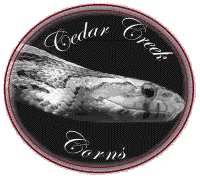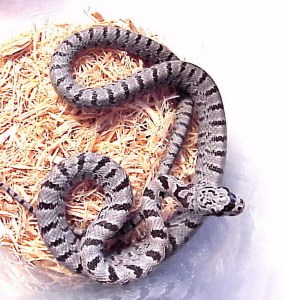
Baird's Rat Care Sheet


Common Name :
|
Baird's Rat Snake (Texas or Mexican locale)
|
Scientific Name :
|
Elaphe bairdi
|
Range :
|
Limited portion of southwestern United States
(Texas Baird's Rat Snake)
and separate population in northern Mexico
(Mexican Baird's Rat Snake)
|
Habitat :
|
Rocky forested regions
|
Hatchling Size :
|
Robust 8 to 12 inches at hatching
|
Adult Size :
|
Average 4 to 5 feet (up to 6 feet) in length
|
Food
Most Baird's rats are fed a diet of mice and/or rats throughout their lives. Hatchlings start on tiny pinkies (small, 1-3 day old hairless mice) and gradually progress up to large mice or weaned rats. Hatchlings do well being fed every 5 to 7 days, while adults are typically maintained at one feeding every 10 to 14 days. We all know 'you are what you eat', so the best way to ensure good nutrition for your snake is to get it's food from a good source. It is essential that the mice were fed a high quality diet and kept disease-free in a sanitary environment. Most rat snakes will accept frozen and then thawed pre-killed mice. Not only does feeding frozen-thawed ensure your snake won't be bitten, scratched, or otherwise maimed by it's intended prey, but the ability to store frozen ensures that you always have a ready food supply in the freezer. An additional benefit to frozen-thawed mice is that freezing and then thawing breaks down the integrity of the fibrous tissues in the mouse, making it easier to digest by the snake. Many pet supply stores will sell frozen rodents; they are also available at good prices at local reptile shows and via the internet by rodent suppliers. Kingsnake.com has a large list of suppliers to choose from. Baird's rats tend to be voracious eaters and rarely miss a meal.
Baird's rat snakes should be fed an appropriately sized food item. A good general rule is not to exceed a prey item wider than 1 and 1/2 times the widest diameter of the snake. Two smaller food items are easier to digest than one larger one. After eating, a corn snake should not be handled for at least 48 hours to give them time to digest. Stressing a snake that has recently eaten may cause them to regurgitate the meal. This is very stressful to the snake and should be avoided if possible.
Water
Clean, fresh water should always be available to your snake in a dish large enough for the snake to curl up in if it so chooses. Some snakes may soak in their water dish to ease shedding or when humidity gets too low. Other snakes may eliminate in their bowls, so regular checks and water changes are a must. Keep the water on the cool end of the tank to slow bacterial growth in standing water.
Baird's rat snakes do best at a lower humidity. Too high a humidity may predispose to repiratory infections.
Heating and Lighting
A gradient should be provided within the environment with the cool side at 70 to 75 degrees and the warm side at 80 to 85 degrees. This allows the snake to choose which temperature is best for it at any given time. There are times when a snake needs to be warmer (like during digestion), and other times when it prefers a cooler temperature. Perhaps the easiest and safest way to create a gradient it through the use of a UTH (under tank heater) on the warm side. Most UTH's are too warm and should be controlled with a rheostat to adjust the warm spot to around 85 degrees on the top of the substrate.
Rat snakes do not require UV lighting like many lizards and some snakes, therefore lighting should be chosen which best enhances the coloration of the snake and environment. Gradually increasing duration of lighting ('day length') during the spring and decreasing 'day length' in the fall may help regulate breeders and encourage breeding behavior in the spring.
Substrate
An ideal substrate for a rat snake should be non-abrasive, absorbant, easy to clean, and non-toxic. Substrates to avoid due to toxins include cedar shavings and some pine shavings. Substrates that are not absorbant and therefore promote bacterial growth include sand and gravel. Many reptile owners prefer aspen shavings, which are absorbant, non-toxic, easy to clean, and allow for tunneling (which corns love to do!) Other acceptable substates favored by many include repti-bark (for a natural look), lizard litter (good clumping ability), newspaper (you don't get a more inexpensive substrate!), and astroturf (can be difficult to keep clean). Keep the habitat clean by scooping out soiled substrate as soon as it is noticed. All substrate should be removed and the cage and its furniture completely cleaned periodically.
Cage Requirements
A good rule of thumb for cage size is 1/2 the snakes length in length. A 20 gallon long aquarium is the minimum recommended size for one adult corn snake. Although corn snakes do love to climb, floor space is the most important consideration when discussing tank size. Keep in mind that corn snakes are escape artists, so a secure lid is a MUST. If they can fit their snout through a crack, the rest of the body will follow. Don't risk it, secure the cage ahead of time.
Baird's rats do not tend to be as secretive as corn snakes, but should still be provided with hides if they choose to utilize them. More often than not, a Baird's rat will be found lying on TOP of the hide. Younger Baird's tend to spend more time in hiding, so remember to provide hides in the cool AND warm areas so the snake can feel comfortably hidden at its chosen temperature. A piece of bark, a paper towl tube, a simple cardboard box, or a decorative ceramic hides all suffice to provide the seclusion a corn seeks. Choose something that allows the snake to curl up inside without a lot of cavernous space so that it may feel secure.
Breeding
Baird's rat snakes are easy to breed in captivity. Brumation is generally recommended to stimulate the onset of the breeding cycle, but is not necessary in all specimens. It is important to be sure the female is large enough to breed before attempting to do so. Breeding a female too early can lead to egg-binding and other complications resulting possibly in the death of the snake. This is less critical in males as they don't have to carry and deliver the eggs. Baird's rats tend to have smaller clutches (6 to 12 eggs) of large, robust hatchlings. Juveniles hatch as grey individuals with black horizontal stripes. These stripes disappear as the snake goes through tremendous color changes in their first year to become light to dark metallic grey with vibrant yellows, oranges, and/or pinks between the scales. Adult coloration is highly variable snake to snake.